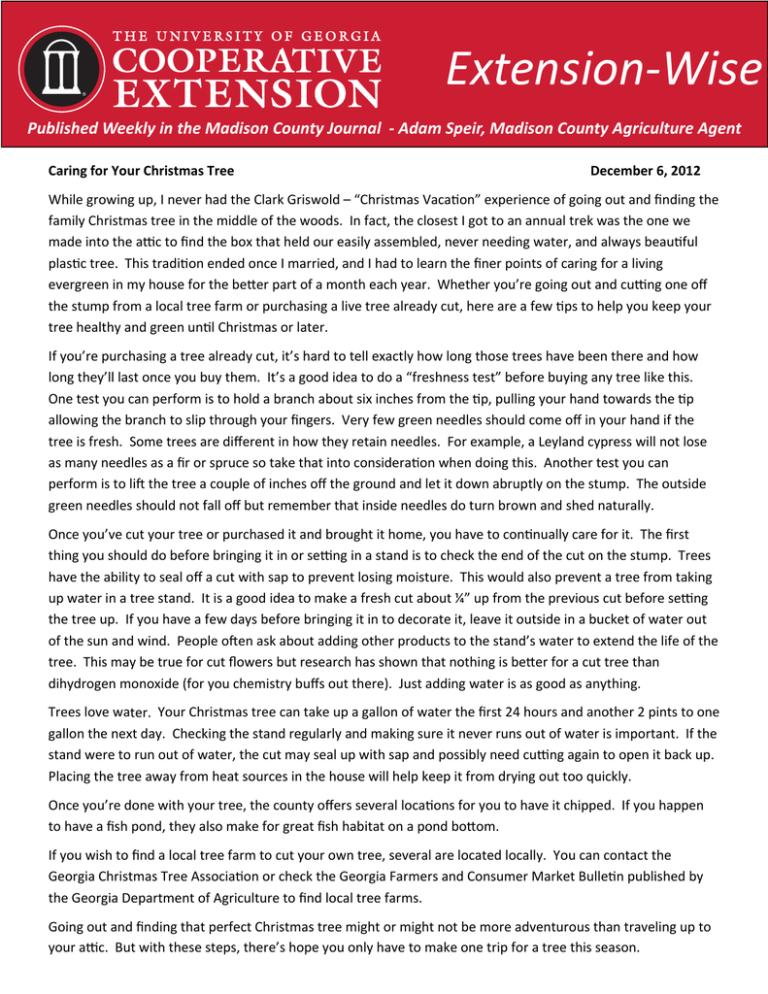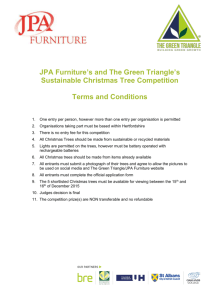Extension‐Wise Published Weekly in the Madison County Journal ‐ Adam Speir, Madison County Agriculture Agent
advertisement

Extension‐Wise Published Weekly in the Madison County Journal ‐ Adam Speir, Madison County Agriculture Agent Caring for Your Christmas Tree December 6, 2012 While growing up, I never had the Clark Griswold – “Christmas Vaca on” experience of going out and finding the family Christmas tree in the middle of the woods. In fact, the closest I got to an annual trek was the one we made into the a c to find the box that held our easily assembled, never needing water, and always beau ful plas c tree. This tradi on ended once I married, and I had to learn the finer points of caring for a living evergreen in my house for the be er part of a month each year. Whether you’re going out and cu ng one off the stump from a local tree farm or purchasing a live tree already cut, here are a few ps to help you keep your tree healthy and green un l Christmas or later. If you’re purchasing a tree already cut, it’s hard to tell exactly how long those trees have been there and how long they’ll last once you buy them. It’s a good idea to do a “freshness test” before buying any tree like this. One test you can perform is to hold a branch about six inches from the p, pulling your hand towards the p allowing the branch to slip through your fingers. Very few green needles should come off in your hand if the tree is fresh. Some trees are different in how they retain needles. For example, a Leyland cypress will not lose as many needles as a fir or spruce so take that into considera on when doing this. Another test you can perform is to li the tree a couple of inches off the ground and let it down abruptly on the stump. The outside green needles should not fall off but remember that inside needles do turn brown and shed naturally. Once you’ve cut your tree or purchased it and brought it home, you have to con nually care for it. The first thing you should do before bringing it in or se ng in a stand is to check the end of the cut on the stump. Trees have the ability to seal off a cut with sap to prevent losing moisture. This would also prevent a tree from taking up water in a tree stand. It is a good idea to make a fresh cut about ¼” up from the previous cut before se ng the tree up. If you have a few days before bringing it in to decorate it, leave it outside in a bucket of water out of the sun and wind. People o en ask about adding other products to the stand’s water to extend the life of the tree. This may be true for cut flowers but research has shown that nothing is be er for a cut tree than dihydrogen monoxide (for you chemistry buffs out there). Just adding water is as good as anything. Trees love water. Your Christmas tree can take up a gallon of water the first 24 hours and another 2 pints to one gallon the next day. Checking the stand regularly and making sure it never runs out of water is important. If the stand were to run out of water, the cut may seal up with sap and possibly need cu ng again to open it back up. Placing the tree away from heat sources in the house will help keep it from drying out too quickly. Once you’re done with your tree, the county offers several loca ons for you to have it chipped. If you happen to have a fish pond, they also make for great fish habitat on a pond bo om. If you wish to find a local tree farm to cut your own tree, several are located locally. You can contact the Georgia Christmas Tree Associa on or check the Georgia Farmers and Consumer Market Bulle n published by the Georgia Department of Agriculture to find local tree farms. Going out and finding that perfect Christmas tree might or might not be more adventurous than traveling up to your a c. But with these steps, there’s hope you only have to make one trip for a tree this season.


